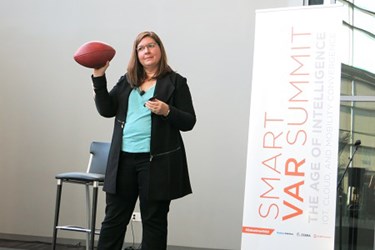Why Football Can Remind Solutions Providers There Are IoT Opportunities Out There


The Internet of Things (IoT) is offering opportunities for managed services providers (MSPs), VARs, and integrators to provide solutions and services. If you need to be convinced, see the real-time player stats that appear at the bottom of your screen during an NFL game.
At the Smart VAR Summit: Age Of Intelligence — IoT, Cloud, And Mobility Convergence, powered by ScanSource, Zebra Technologies, and Business Solutions, Jill Stelfox, VP and general manager of Location Solutions at Zebra Technologies, presented “Motion Analytics 2025: The Future of Sports Analytics.” The presentation that detailed Zebra’s NFL player tracking solution was followed by an opportunity for attendees at the event on October 14 to demonstrate the solution in action at Lincoln Financial Field in Philadelphia, PA.
Through the use of active RFID, the solution tracks the football, players, officials, and chains. Receivers around all 32 NFL stadiums capture information that is then relayed to servers. Stelfox said the solution’s ultra-wide band technology is perfect for the stadium setting and doesn’t interfere with Wi-Fi, smartphone, or the communications systems used by coaching staffs. Player tags, one in each shoulder pad, are placed during the preseason, and are activated as players enter and exit locker rooms.
Statistics for broadcast are sent within a half second, and within 2 seconds, data is moved to the NFL cloud and to Zebra’s network command center where it is “sliced,” with appropriate information sent to specific groups, including a statistics company. Stelfox said the command center is an illustration of how managed services will support IoT solutions. “We can see every tag, every player, every sensor, every cable,” she commented. “For the channel, think about how you can gain new services from this — managing each little device. Are they on? Are they working?”
Stelfox said the solution, which delivers on Zebra Technologies’ promise to provide Enterprise Asset Intelligence, allows the NFL to collect, analyze, and act on data quickly. The solution provides coaching staffs during practice with data — sent to tablets on the field via Bluetooth — including information on hydration levels and heart rate, how particular categories of players are performing, and how individuals in certain groups compare to each other. The data could also be valuable in the event a team must replace a player — providing information on potential recruits. Now available in the command center, and possibly available to coaches in the future, the solution shows where the team is effective on the field, which could help make decisions based on matchups in real-time during the game.
“We see this becoming the core system of record for the NFL. Today we are about half way there,” she said. The goal over Zebra Technologies’ five-year engagement with the NFL is to move from recording statistics by hand to entirely tracking-based statistics, if possible.
Segments of the data generated by the solution are sold. Stelfox told solutions providers at the event that they may conclude, “I shouldn’t be in the hardware business. I should be in the data business.” She said the future may prove that hardware only is considered a tool to deliver the data. “So should they pay for hardware or should they pay for the data usage?” she asked.
Stelfox pointed out that the same software used in the NFL application is also at work in industrial applications. It allows users to use active or passive RFID or beacons to collect data, and it provides the means to manage devices and data and, in many cases, to integrate with enterprise resource planning (ERP) or other systems.
She also pointed out that solving an end user’s problem with Enterprise Asset Intelligence solutions often results in data that is valuable to a variety of departments within an organization. For example, a U.S. manufacturer’s risk management department deployed a solution to keep its workers safe when using motorized platforms, but now shares data throughout the company on efficiency and production. Another example Stelfox shared was that of a solution deployed in Europe to manage dairy cows due to a shortage of farm workers. This solution has provided data on herd size and location, as well as feed requirements and milk output — and the solution can predict the price of milk. In both cases, these benefits weren’t the primary goals for deploying the solutions, but, said Stelfox, “That’s the power of the data.”
She advised, “Think about that as you price it and as you plan for managed services and what it will mean for your business. It’s only going to happen more and more with IoT.”
For additional coverage of the Smart VAR Summit, visit http://www.bsminfo.com/solution/smart-var.
